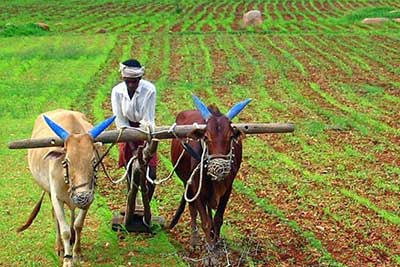Date: 22/12/2022
Relevance: GS-3: Major Crops - Cropping Patterns in various parts of the country, - Different Types of Irrigation and Irrigation Systems; Storage, Transport, and Marketing of Agricultural Produce and Issues and Related Constraints
Key Phrases: Agro-climatic zones, higher-than-normal temperature, higher-than-normal rains, Russia-Ukraine war, precision farming, hydroponics, post-harvest, and storage infrastructure, GM Mustard, Farm laws, parboiled rice.
Why in News?
- The year 2022 has been a game-changing year for Indian agriculture on many counts but was influenced by the extreme events both globally and within the country.
Changing weather patterns:
- Farmers in the country were impacted by the rising incidents of unfavourable and changing weather patterns throughout the year across different Agro-climatic zones.
- If the higher than-normal temperature levels during the early part of the year shrunk the wheat output in the key producing regions of the North.
- The patchy rains during the crucial monsoon period in the eastern parts of the country influenced the rice cropping pattern.
- The higher-than-normal rains impacted the output of pulses and other plantation crops such as coffee and pepper among others, besides influencing yields of cotton in the Southern States.
Import curbs:
- The Russia-Ukraine war triggered the export demand for Indian foodgrains — mainly wheat, rice, and corn.
- The farmers largely benefitted from the surge in prices of various agro commodities such as wheat, corn, cotton, and oilseeds such as mustard, soybean, and groundnut among others, as a fallout of the Ukraine war.
- The rise in food prices impacted the consumer wallets and also forced the government to keep the imports open for commodities like pulses while placing curbs on shipments of wheat, flour, broken rice, and sugar among others.
- Besides, it also forced the government to renew its focus on initiatives to boost domestic oilseeds such as sunflower.
Tech adoption:
- The technology adoption in agriculture continued to gain pace with the use of drones, precision farming, and hydroponics among others making further inroads aided by the deeper penetration of mobile connectivity and government policy support.
- This has not only helped attract the investors’ interest but also helped expand the fledgling start-up ecosystem, which is seen as helping strengthen the post-harvest and storage infrastructure besides the agri-marketing mechanism.
GM Mustard:
- After what the industry called a policy paralysis with regard to considering GM trials for over a decade, the year also saw the clearance for GM mustard’s environmental release by the GEAC, which has rekindled hope among the research-based agribiotech companies.
- GM is a key policy, but the decision, however, is embroiled in a huge controversy, with anti-GMO activists, farmers’ unions, and a section of scientists strongly opposing the move.
- They even moved the Supreme Court, challenging the move to allow GM mustard for commercial release.
Farm laws:
- As regards Farm Laws, though the opinion was sharply divided on whether withdrawing the laws that promised reforms was a good or a retrograde decision, the fact that the farmers went back to the fields augured very well.
- Three Farm Laws were:
- Farmers Produce Trade and Commerce (Promotion and Facilitation) Act, 2020: It is aimed at allowing trade in agricultural produce outside the existing APMC (Agricultural Produce Market Committee) mandis.
- Farmers (Empowerment and Protection) Agreement on Price Assurance and Farm Services Act, 2020: It seeks to provide a framework for contract farming.
- Essential Commodities (Amendment) Act, 2020: It is aimed at removing commodities such as cereals, pulses, oilseeds, edible oils, onion, and potatoes from the list of essential commodities.
Telangana’s paddy procurement case:
- The year also witnessed a bitter fight between the Centre and the Telangana government over the procurement of parboiled rice.
- The Telangana government demanded that the Centre procure paddy (rice with husk) from the State at the minimum support price (MSP) to aid farmers.
- However, the Centre maintained that it can only procure raw rice and very less parboiled rice as per demand.
Parboiled Rice
- While raw rice is produced by drying and milling paddy without steaming, parboiled rice is cooked partially and then dehydrated and dried out for sale to consumers.
Fortification of rice under PDS:
- After doing pilots in several States, the Union Ministry of Consumer Affairs, Food, and Public Distribution released SOPs (Standard Operating Procedures) early this year, mandating that millers and State procurement agencies follow certain measures to bring uniformity and ensure the quality of the fortified rice.
- The SOPs include how millers should print logos of +F, endorsed by the FSSAI (Food Safety and Standards Authority of India).
- About 10 percent of all the samples should be sent to FSSAI-approved and NABL (National Accreditation Board for Testing and Calibration Laboratories)-recognized laboratories.
- The SOPs are going to be implemented in 2023, giving a boost to the delivery of fortified rice under the public distribution schemes.
Conclusion:
- For 2023, what remains to be seen on the domestic front is whether the government will succeed in the use of Direct Benefit Transfers for the farmers as well as how successfully the sector is cushioned from the global challenges.
- A well-coordinated action and strategy between the Centre and the States is needed to ensure that agriculture marches to the next stage of development along with other sectors and copes with global dynamics.
Source: The Hindu BL
Mains Question:
Q. “For holistic growth of the agriculture sector in India in the coming years, the key challenge will be to cushion the impact of global dynamics.” Examine.






















